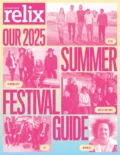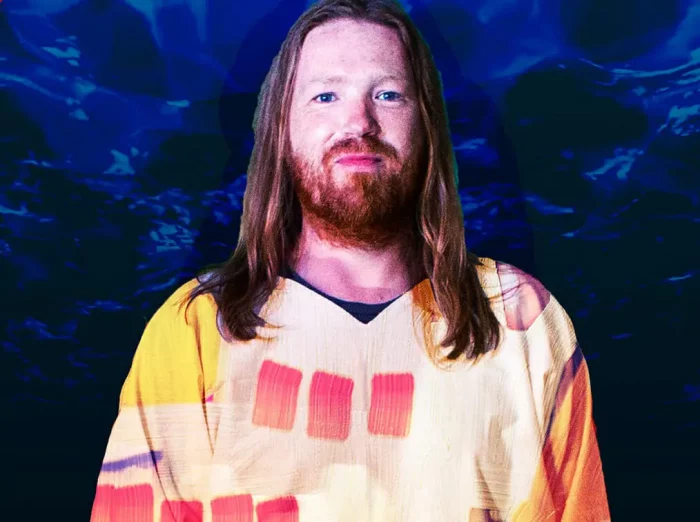Reed Mathis briskly enters the room with an armful of items, including his trademark bass. Setting down most of these, he politely introduces himself with a beaming smile and removes his shoes, opting for comfort, as he proceeds to lounge on the oversized purple sofa. As our conversation begins, he plucks a series of notes nonchalantly, as if he’s simply adding some background music to our discussion.
During the sit-down, which occurred in mid-February, the Bay Area staple told tales from the studio and set the scene for his current project: a two-part album with Jay Lane, Adam MacDougall and Giulio Xavier Cetto, which is currently in the process of being mixed. With live music and the community at his core, Mathis traverses a steady stream of memories that honor the San Francisco players that predated his rise.
Through conversation, the celebrated musician–who is perhaps best known for his 15-year tenure with Jacob Fred Jazz Odyssey and, most recently, reviving that material and dropping four archival deep-dives in addition to gassing momentum into his Electric Beethoven effort–dives into his San Francisco roots. Along the way, he pays his respects to Phil Lesh’s Terrapin Crossroads, shares tell of his Grateful Dead education a la Steve Kimock and boasts about the magic of both Billys (Strings and Kreutzmann, respectively).
What’s been keeping you busy?
Well, in two weeks I’m mixing my double album. I’ve been working on it forever. The album’s all recorded. It’s a hundred minutes, so we’re going to have to split it between two releases.
What else can you spill about the new project?
It’s my favorite thing I’ve ever made. [We recorded at] this place in Oakland, Calif., that’s called the Gray Room, where I’ve made a ton of shit over the years.
Who did you work with on the album and how did you all mesh in the studio?
In the initial sessions it was me on guitar, Jay Lane on drums, Adam MacDougall on keys, and then this amazing young bass player from San Francisco, Giulio Xavier Cetto. He’s probably the most in-demand upright player in the Bay Area. He slayed.
Guilio had never met Jay–And Jay Lane comes off as such a bohemian, California beatnik dude, but he is such a heavy jazz cat! And the week before we did the first session, Jay had been at Radio City Music Hall with Bob Weir. And Ron Carter sat in, who was Miles Davis’s bass player and one of the greatest people to ever do it. I could tell when Guilio rolled in, he was sort of sizing us all up. We never met, and this was 30 minutes before recording the first take. He was sort of like, “OK, hippies. Right on.” And then I was like, “How was playing with Ron Carter, dude?” And Jay was like, “Oh man, holy crap.” And he went right into. Guilio was like, “Ron? like The Ron Carter?” And that won so many points.
That’s awesome. What was it like playing during those first recording sessions?
It was awesome. I was doing a little bit of singing just to guide, but mostly I did a lot more guitar soloing than I’m actually going to use on the record. Whenever I’m soloing, those three would lock into a support stance. And I was like if I pull out that guitar, I can sing over that. So I ended up getting all this raw material I can use to sing over.
I feel like I tried a lot of things in those sessions that might not have worked, and they all went really well. Every tune. We would do a 45-minute take and I would just talk us through it. I’d be like, “OK, let’s just sit on the one chord,” and we’d sit on the one chord. Then I’d be like, “Let’s try a different groove.” And we’d try a different groove. Then I’d be like, “Let’s play the verse with this groove.” So we’d try the verse with that groove for 45 minutes and we would just roll tape and try things. Because I knew I was going to be the editor, I wasn’t afraid to get too much.
Since we don’t want to give too much away let’s pivot. You’re always playing live. How did that become such a core part of your musical identity?
In the Bay Area, we really have Phil Lesh to thank, because Terrapin Crossroads existed for 10 years. They had live music seven nights a week and they paid between four and 20 musicians each night.
Often you wouldn’t know who you were playing with. Or, for instance, if they were like, “You can have Thursday. Who do you want in your band?” And I would just put together a band with no rehearsal. If you wanted to lead a song, you were expected to bring a chart. And we would just airdrop stuff. Like “I want to try this R.E.M. song.” And boom here’s a chart and it goes like this. Then we would just play it for a half hour and fucking improvise and jam.
So basically what Terrapin Crossroads did was create this 60-person ensemble, that all have played together. Dozens and dozens of times and we were all working in whatever configurations. It’s like being on a baseball team or something. It was crazy.
Is that how you started working with Lesh?
Indirectly. The first time I ever played at Terrapin Crossroads was as part of the Marco Benevento Trio. The first five Marco albums were us, and Matt Chamberlain. So we were playing at Terrapin Crossroads–I think they just opened–and Lesh played with us during the second set. We did two basses. That was the first time I had jammed with him or seen him in person.
Were you into the Grateful Dead growing up?
No, it wasn’t until I started hanging out with Steve Kimock when I was in my early-20s. But then he started hiring me. When I was rolling with him, there was so much Grateful Dead talk and energy. And I was like, if there’s ever a crew in which to learn the ways of this cult, this is probably the right crew. [Laughs.]
Speaking of your Dead connection, is there any chance we’ll see a Billy & the Kids reunion?
We are in a constant state of checking everybody’s availability.
Do you think it would be that same lineup of players if you were ever able to pull something together?
I don’t know. But, Billy Strings fucking changed my life. That week in Hawaii, my whole approach to music shifted. There’s something about him. He just rolled in and he almost never plays electric guitar. He had played acoustic guitar his whole life. But he was on a Les Paul from the first note of rehearsal, and we were all just like, “What is going on?” And he was playing all this Slayer shit and Django Reinhardt solos. Right away I was like, “You know your history.” His presence just lifts everybody up. After a week of playing with him, I felt like I had a new relationship with music. And we did the Red Rocks shows.
That must have been a magical experience.
Just walking out on stage at Red Rocks the first night, there was this ovation before we’d even played a note. That felt cathartic for everybody there. We also hadn’t done this in a year and a half. It felt like the audience was close to tears.
Before we even started playing the spirit was there. We were all really at ease. The music was effortless and I turned around and the lights were going crazy–nobody could have seen this if they weren’t as close to him as I was–but I turned around and I looked at Kreutzmann. He was playing, and he had his eyes closed and he just looked so happy. And without opening his eyes, I saw him go, “Thank you.” I don’t know who he was directing it at. Maybe Jerry?



1 Comment comments associated with this post
Reed Mathis' In The Now Feat. Jay Lane to Open for Circles Around the Sun in Mill Valley
March 29, 2024 at 11:00 am[…] For more on Mathis, read his 2023 Jambands.com interview: Music Is Magic. […]